Improved Physicochemical Stability and High Ion Transportation of Poly(Arylene Ether Sulfone) Blocks Containing a Fluorinated Hydrophobic Part for Anion Exchange Membrane Applications
Abstract
:1. Introduction
2. Experimental
2.1. Materials
2.2. Synthesis of QN-PAES Membranes
2.2.1. Synthesis of Poly(arylene sulfone) (PAS) Hydrophilic Precursors
2.2.2. Synthesis of Fluorinated Poly(arylene ether) (PAE) Hydrophobic Oligomers
2.2.3. Polymerization Reaction with PAS Hydrophilic Precursor and PAE Hydrophobic Oligomer
2.2.4. Chloromethylation of PAES Block Copolymers
2.2.5. Fabrication of Membranes, Quaternization, and Anionization
2.3. Chraterizations
3. Results and Discussion
3.1. Synthesis and Characterization of PAS, PAE, and PAES Polymer
3.2. Synthesis and Characterization of CM-PAES and QN-PAES
3.3. Thermal Stability
3.4. Mechanical Behaviors
3.5. Water Uptake, IEC, and Dimensional Properties
3.6. Morphology
3.7. Hydroxide Conductivity and Activation Energy
3.8. Alkaline Stability
3.9. Single Cell Performance
4. Conclusions
Supplementary Materials
Author Contributions
Funding
Conflicts of Interest
References
- Liu, X.; Peng, F.Y.; Lou, G.F. Liquid water transport characteristics of porous diffusion media in polymer electrolyte membrane fuel cells: A review. J. Power Sources 2015, 299, 85–96. [Google Scholar] [CrossRef]
- Dijoux, E.; Steiner, N.Y.; Benne, M.; Péra, M.C.; Pérez, B.G. A review of fault tolerant control strategies applied to proton exchange membrane fuel cell systems. J. Power Sources 2017, 359, 119–133. [Google Scholar] [CrossRef] [Green Version]
- Ranjani, M.; Yoo, D.J.; Kumar, G.G. Sulfonated Fe3O4@SiO2 nanorods incorporated sPVdF nanocomposite membranes for DMFC applications. J. Membr. Sci. 2018, 555, 497–506. [Google Scholar] [CrossRef]
- Peighambardoust, S.J.; Rowshanzamir, S.; Amjadi, M. Review of the proton exchange membranes for fuel cell applications. Int. J. Hydrog. Energy 2010, 35, 9349–9384. [Google Scholar] [CrossRef]
- Lee, K.H.; Chu, J.Y.; Kim, A.R.; Nahm, K.S.; Kim, C.J.; Yoo, D.J. Densely sulfonated block copolymer composite membranes containing phosphotungstic acid for fuel cell membranes. J. Membr. Sci. 2013, 434, 35–43. [Google Scholar] [CrossRef]
- Lee, N.W.; Duong, D.T.; Kim, D.J. Cyclic ammonium grafted poly(arylene ether ketone) hydroxide ion exchange membranes for alkaline water electrolysis with high chemical stability and cell efficiency. Electrochim. Acta 2018, 271, 150–157. [Google Scholar] [CrossRef]
- Kraytsberg, A.; Ein-Eli, Y. Review of advanced materials for proton exchange membrane fuel cells. Energy Fuels 2017, 28, 7303–7330. [Google Scholar] [CrossRef]
- Jannasch, P.; Weiber, E.A. Configuring anion-exchange membranes for high conductivity and alkaline stability by using cationic polymers with tailored side chains. Macromol. Chem. Phys. 2016, 217, 1108–1118. [Google Scholar] [CrossRef]
- Merle, G.; Wessling, M.; Nijmeijer, K. Anion exchange membranes for alkaline fuel cells: A review. J. Membr. Sci. 2011, 377, 1–35. [Google Scholar] [CrossRef]
- Varcoe, J.R.; Atanassov, P.; Dekel, D.R.; Herring, A.M.; Hickner, M.A.; Kohl, P.A.; Kucernak, A.R.; Mustain, W.E.; Nijmeijer, K.; Scott, K.; et al. Anion-exchange membranes in electrochemical energy systems. Energy Environ. Sci. 2014, 7, 3135–3191. [Google Scholar] [CrossRef] [Green Version]
- Dekel, D.R. Review of cell performance in anion exchange membrane fuel cells. J. Power Sources 2018, 375, 158–169. [Google Scholar] [CrossRef]
- Hao, J.; Gao, X.; Jiang, Y.; Zhang, H.; Luo, J.; Shao, Z.; Yi, B. Crosslinked high-performance anion exchange membranes based on poly(styrene-b-(ethylene-co-butylene)-b-styrene). J. Membr. Sci. 2018, 551, 66–75. [Google Scholar] [CrossRef]
- Li, N.; Wang, L.; Hickner, M. Cross-linked comb-shaped anion exchange membranes with high base stability. Chem. Commun. 2014, 50, 4092–4095. [Google Scholar] [CrossRef] [PubMed]
- Tanaka, M.; Fukasawa, K.; Nishino, E.; Yamahuchi, S.; Yamada, K.; Tanaka, H.; Bae, B.C.; Miyatake, M. Anion conductive block poly(arylene ether)s: Synthesis, properties, and application in alkaline fuel cells. J. Am. Chem. Soc. 2011, 133, 10646–10654. [Google Scholar] [CrossRef] [PubMed]
- Rao, A.H.N.; Nam, S.Y.; Kim, T.H. Comb-shaped alkyl imidazolium-functionalized poly(arylene ether sulfone)s as high performance anion-exchange membranes. J. Mater. Chem. A 2015, 3, 8571–8580. [Google Scholar] [CrossRef]
- Chu, J.Y.; Lee, K.H.; Kim, A.R.; Yoo, D.J. Graphene-mediated organic-inorganic composites with improved hydroxide conductivity and outstanding alkaline stability for anion exchange membranes. Compos. Pt. B-Eng. 2019, 164, 324–332. [Google Scholar] [CrossRef]
- Wang, C.; Xu, C.; Shen, B.; Zhao, X.; Li, J. Stable poly(arylene ether sulfone)s anion exchange membranes containing imidazolium cations on pendant phenyl rings. Electrochim. Acta 2016, 190, 1057–1065. [Google Scholar] [CrossRef]
- Kwon, S.H.; Rao, A.H.N.; Kim, T.H. Anion exchange membranes based on terminally crosslinked methyl morpholinium-functionalized poly(arylene ether sulfone). J. Power Sources 2018, 375, 421–432. [Google Scholar] [CrossRef]
- Li, Y.; Sniekers, J.; Malaquias, J.C.; Goethem, C.V.; Binnemans, K.; Fransaer, J.; Vankelecom, I.F.J. Crosslinked anion exchange membranes prepared from poly(phenylene oxide) (PPO) for non-aqueous redox flow batteries. J. Power Sources 2018, 378, 338–344. [Google Scholar] [CrossRef]
- Li, Q.; Liu, L.; Miao, Q.; Jin, B.; Bai, R. A novel poly(2,6-dimethyl-1,4-phenylene oxide) with trifunctional ammonium moieties for alkaline anion exchange membranes. Chem. Commun. 2014, 50, 2791–2793. [Google Scholar] [CrossRef]
- Pan, J.; Han, J.; Zhu, L.; Hickner, M.A. Cationic side-chain attachment to poly(phenylene oxide) backbones for chemically stable and conductive anion exchange membranes. Chem. Mat. 2017, 29, 5321–5330. [Google Scholar] [CrossRef]
- Sajjad, S.D.; Hong, Y.; Liu, F. Synthesis of guanidinium-based anion exchange membranes and their stability assessment. Polym. Adv. Technol. 2013, 25, 108–116. [Google Scholar] [CrossRef]
- Lin, X.; Wu, L.; Liu, Y.; Ong, A.L.; Poynton, S.D.; Varcoe, J.R.; Xu, T. Alkali resistant and conductive guanidinium-based anion-exchange membranes for alkaline polymer electrolyte fuel cells. J. Power Sources 2017, 55, 65–72. [Google Scholar] [CrossRef]
- Liu, L.; Li, Q.; Dai, J.; Wang, H.; Jin, B.; Rai, R. A facile strategy for the synthesis of guanidinium-functionalized polymer as alkaline anion exchange membrane with improved alkaline stability. J. Membr. Sci. 2014, 453, 52–60. [Google Scholar] [CrossRef]
- Xu, Y.; Ye, N.; Zhang, D.; Yang, J.; He, R. Ionic crosslinking of imidazolium functionalized poly(aryl ether ketone) by sulfonated poly(ether ether ketone) for anion exchange membranes. J. Colloid Interface Sci. 2017, 497, 333–342. [Google Scholar] [CrossRef] [PubMed]
- Yang, J.; Liu, C.; Hao, Y.; He, X.; He, R. Preparation and investigation of various imidazolium-functionalized poly(2,6-dimethyl-1,4-phenylene oxide) anion exchange membranes. Electrochim. Acta 2016, 207, 112–119. [Google Scholar] [CrossRef]
- Gu, F.; Dong, H.; Li, Y.; Si, Z.; Yan, F. Highly stable N3-substituted imidazolium-based alkaline anion exchange membranes: Experimental studies and theoretical calculations. Macromolecules 2014, 47, 208–216. [Google Scholar] [CrossRef]
- Hugar, K.M.; Kostalik, H.A.; Goates, G.W. Imidazolium cations with exceptional alkaline stability: A systematic study of structure–stability relationships. J. Am. Chem. Soc. 2015, 137, 8730–8737. [Google Scholar] [CrossRef]
- Long, H.; Pivovar, B. Hydroxide degradation pathways for imidazolium cations: A DFT study. J. Phys. Chem. C 2014, 118, 9880–9888. [Google Scholar] [CrossRef]
- Zhang, W.; Liu, Y.; Jackson, A.C.; Savage, A.M.; Ertem, S.P.; Tsai, T.H.; Seifert, S.; Beyer, F.L.; Liberatore, M.W.; Herring, A.M.; et al. Achieving continuous anion transport domains using block copolymers containing phosphonium cations. Macromolecules 2016, 49, 4714–4722. [Google Scholar] [CrossRef]
- Marino, M.G.; Kreuer, K.D. Alkaline stability of quaternary ammonium cations for alkaline fuel cell membranes and ionic liquids. Chem. Sus. Chem. 2015, 8, 513–523. [Google Scholar] [CrossRef] [PubMed]
- Tomé, L.C.; Guerreiro, D.C.; Teodoro, R.M.; Alves, V.D.; Marrucho, I.M. Effect of polymer molecular weight on the physical properties and CO2/N2 separation of pyrrolidinium-based poly(ionic liquid) membranes. J. Membr. Sci. 2018, 549, 267–274. [Google Scholar] [CrossRef]
- Dong, X.; Lv, D.; Zheng, J.; Xue, B.; Bi, W.; Li, S.; Zhang, S. Pyrrolidinium-functionalized poly(arylene ether sulfone)s for anion exchange membranes: Using densely concentrated ionic groups and block design to improve membrane performance. J. Membr. Sci. 2017, 535, 301–311. [Google Scholar] [CrossRef]
- Zha, Y.; Disabb-Miller, M.L.; Johanson, Z.D.; Hickner, M.A.; Tew, G.N. Metal-cation-based anion exchange membranes. J. Am. Chem. Soc. 2012, 134, 4493–4496. [Google Scholar] [CrossRef]
- Zhang, X.; Shi, Q.; Chen, P.; Zhou, J.; Li, S.; Xu, H.; Chen, X.; An, Z. Block poly(arylene ether sulfone) copolymers tethering aromatic side-chain quaternary ammonium as anion exchange membranes. Polym. Chem. 2018, 9, 699–711. [Google Scholar] [CrossRef]
- Kumar, G.G.; Kim, A.R.; Nahm, K.S.; Yoo, D.J.; Elizabeth, E. High ion and lower molecular transportation of the poly vinylidene fluoride–hexafluoro propylene hybrid membranes for the high temperature and lower humidity direct methanol fuel cell applications. J. Power Sources 2010, 195, 5922–5928. [Google Scholar] [CrossRef]
- Yoo, T.H.; Aziz, M.A.; Oh, K.J.; Shanmugam, S. Modified sulfonated poly(arylene ether) multiblock copolymers containing highly sulfonated blocks for polymer electrolyte membrane fuel cells. J. Membr. Sci. 2017, 542, 102–109. [Google Scholar] [CrossRef]
- Tanaka, M.; Koike, M.; Miyatake, K.; Watanabe, M. Synthesis and properties of anion conductive ionomers containing fluorenyl groups for alkaline fuel cell applications. Polym. Chem. 2011, 2, 99–106. [Google Scholar] [CrossRef]
- Xu, J.; Liu, B.; Luo, X.; Li, M.; Zang, H.; Zhang, H.; Wang, Z. Construction of ion transport channels by grafting flexible alkyl imidazolium chain into functional poly(arylene ether ketone sulfone) as anion exchange membranes. Int. J. Hydrog. Energy 2017, 42, 25996–26006. [Google Scholar] [CrossRef]
- Chu, J.Y.; Kim, A.R.; Nahm, K.S.; Lee, H.K.; Yoo, D.J. Synthesis and characterization of partially fluorinated sulfonated poly(arylene biphenylsulfone ketone) block copolymers containing 6F-BPA and perfluorobiphenylene units. Int. J. Hydrog. Energy 2013, 38, 6268–6274. [Google Scholar] [CrossRef]
- Kim, A.R.; Vinothkannan, M.; Park, C.J.; Yoo, D.J. Alleviating the mechanical and thermal degradations of highly sulfonated poly(ether ether ketone) blocks via copolymerization with hydrophobic unit for intermediate humidity fuel cells. Polymers 2018, 10, 1346. [Google Scholar] [CrossRef]
- Dong, X.; Xue, B.; Qian, H.; Zheng, J.; Li, S.; Zhang, S. Novel quaternary ammonium microblock poly(p-phenylene-co-aryl ether ketone)s as anion exchange membranes for alkaline fuel cells. J. Power Sources 2017, 342, 605–615. [Google Scholar] [CrossRef]
- Liu, L.; Ahlfield, J.; Tricker, A.; Chu, D.; Kohl, P.A. Anion conducting multiblock copolymer membranes with partial fluorination and long head-group tethers. J. Mater. Chem. A 2016, 4, 16233–16244. [Google Scholar] [CrossRef]
- Lai, A.N.; Wang, L.S.; Lin, C.X.; Zhuo, Y.Z.; Zhang, Q.G.; Zhu, A.M.; Liu, Q.L. Phenolphthalein-based poly(arylene ether sulfone nitrile)s multiblock copolymers as anion exchange membranes for alkaline fuel cells. ACS Appl. Mater. Interfaces 2015, 15, 8284–8292. [Google Scholar] [CrossRef]
- Xu, J.; Ma, L.; Han, H.; Ni, H.; Wang, Z.; Zhang, H. Synthesis and properties of a novel sulfonated poly(arylene ether ketone sulfone) membrane with a high ꞵ-value for direct methanol fuel cell applications. Electrochim. Acta 2014, 146, 688–696. [Google Scholar] [CrossRef]
- Vinothkannan, M.; Kim, A.R.; Nahm, K.S.; Yoo, D.J. Ternary hybrid (SPEEK/SPVdF-HFP/GO) based membrane electrolyte for the applications of fuel cells: Profile of improved mechanical strength, thermal stability and proton conductivity. RSC Adv. 2016, 6, 108851–108863. [Google Scholar] [CrossRef]
- Lee, K.H.; Chu, J.Y.; Kim, A.R.; Yoo, D.J. Facile fabrication and characterization of improved proton conducting sulfonated poly(arylene biphenylether sulfone) blocks containing fluorinated hydrophobic units for proton exchange membrane fuel cell applications. Polymers 2018, 10, 1367. [Google Scholar] [CrossRef]
- Kim, A.R.; Vinothkannan, M.; Yoo, D.J. Artificially designed, low humidifying organic-inorganic (SFBC-50/FSiO2) composite membrane for electrolyte applications of fuel cells. Compos. Part B Eng. 2017, 130, 103–118. [Google Scholar] [CrossRef]
- Lee, K.H.; Chu, J.Y.; Kim, A.R.; Yoo, D.J. Enhanced performance of a sulfonated poly(arylene ether ketone) block copolymer bearing pendant sulfonic acid groups for polymer electrolyte membrane fuel cells operating at 80% relative humidity. ACS Appl. Mater. Interfaces 2018, 10, 20835–20844. [Google Scholar] [CrossRef]
- Singh, A.K.; Pandey, R.P.; Shahi, V.K. Fluorenyl phenolphthalein groups containing a multi-block copolymer membrane for alkaline fuel cells. RSC. Adv. 2014, 4, 22186–22193. [Google Scholar] [CrossRef]
- Lin, C.X.; Wang, X.Q.; Hu, E.N.; Yang, Q.; Zhang, Q.G.; Zhu, A.M.; Liu, Q.L. Quaternized triblock polymer anion exchange membranes with enhanced alkaline stability. J. Membr. Sci. 2017, 541, 358–366. [Google Scholar] [CrossRef]
- Li, X.; Yu, Y.; Liu, Q.; Meng, Y. Synthesis and characterization of anion exchange membranes based on poly(arylene ether sulfone)s containing various cations functioned tetraphenyl methane moieties. Int. J. Hydrog. Energy 2013, 38, 11067–11073. [Google Scholar] [CrossRef]
- Shen, K.; Zhang, Z.; Zhang, H.; Pang, J.; Jiang, Z. Poly(arylene ether ketone) carrying hyperquaternized pendants: Preparation, stability and conductivity. J. Power Sources 2015, 287, 439–447. [Google Scholar] [CrossRef]
- Nie, G.; Li, X.; Tao, J.; Wu, W.; Liao, S. Alkali resistant cross-linked poly(arylene ether sulfone)s membranes containing aromatic side-chain quaternary ammonium groups. J. Membr. Sci. 2015, 474, 187–195. [Google Scholar] [CrossRef]
- Lu, W.; Shao, Z.G.; Zhang, G.; Li, J.; Zhao, Y.; Yi, B. Preparation of anion exchange membranes by an efficient chloromethylation method and homogeneous quaternization/crosslinking strategy. Solid State Ion. 2013, 245–246, 8–18. [Google Scholar] [CrossRef]
- Maurya, S.; Shin, S.H.; Kim, M.K.; Yun, S.H.; Moon, S.H. Stability of composite anion exchange membranes with various functional groups and their performance for energy conversion. J. Membr. Sci. 2013, 443, 28–35. [Google Scholar] [CrossRef]
- Kim, E.Y.; Lee, S.J.; Woo, S.H.; Park, S.H.; Yim, S.D.; Shin, D.W.; Bae, B.C. Synthesis and characterization of anion exchange multi-block copolymer membranes with a fluorine moiety as alkaline membrane fuel cells. J. Power Sources 2017, 359, 568–576. [Google Scholar] [CrossRef]
- Zhang, Z.; Shen, K.; Lin, L.; Pang, J. Anion exchange membranes based on tetra-quaternized poly(arylene ether ketone). J. Membr. Sci. 2016, 497, 318–327. [Google Scholar] [CrossRef]
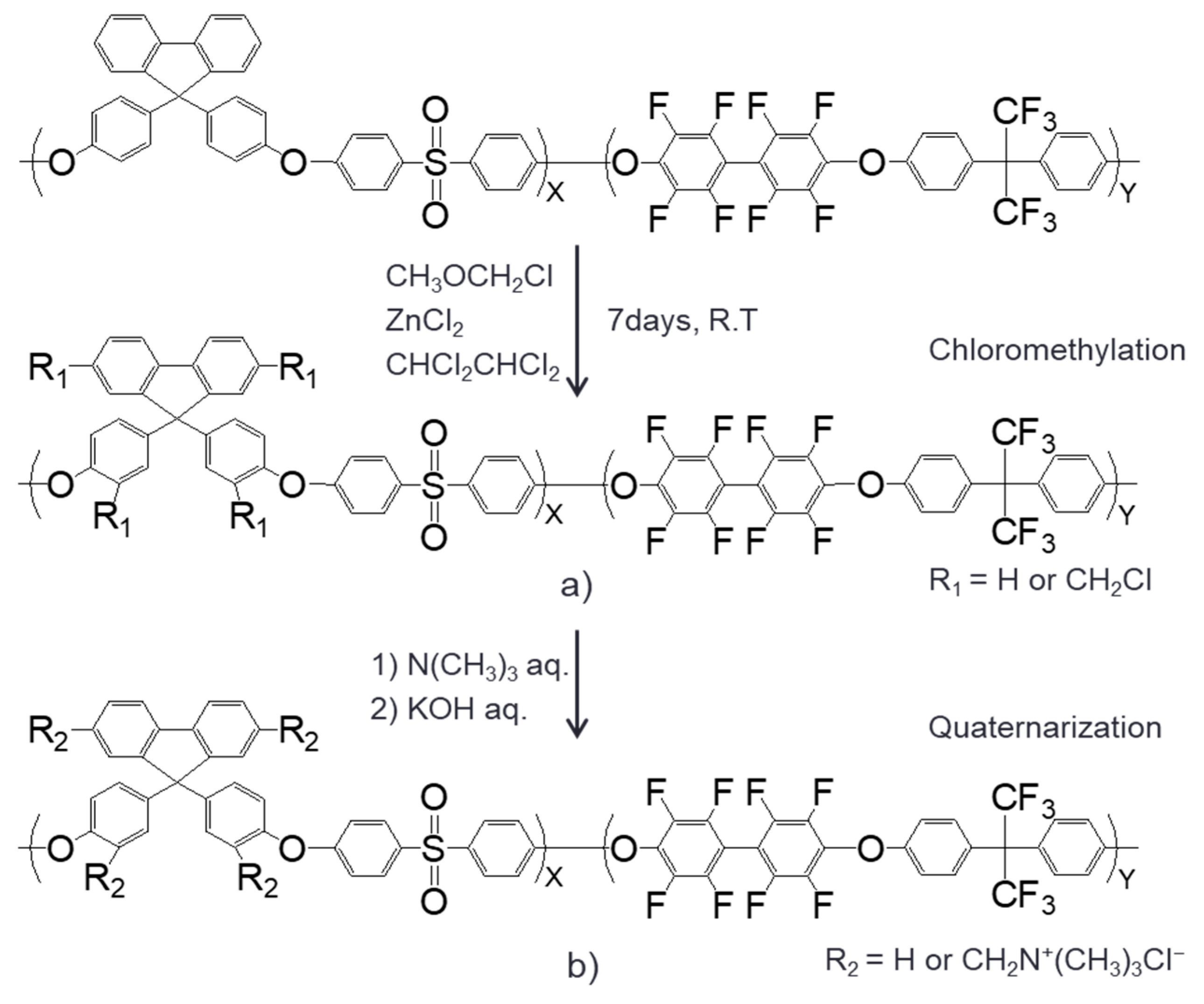


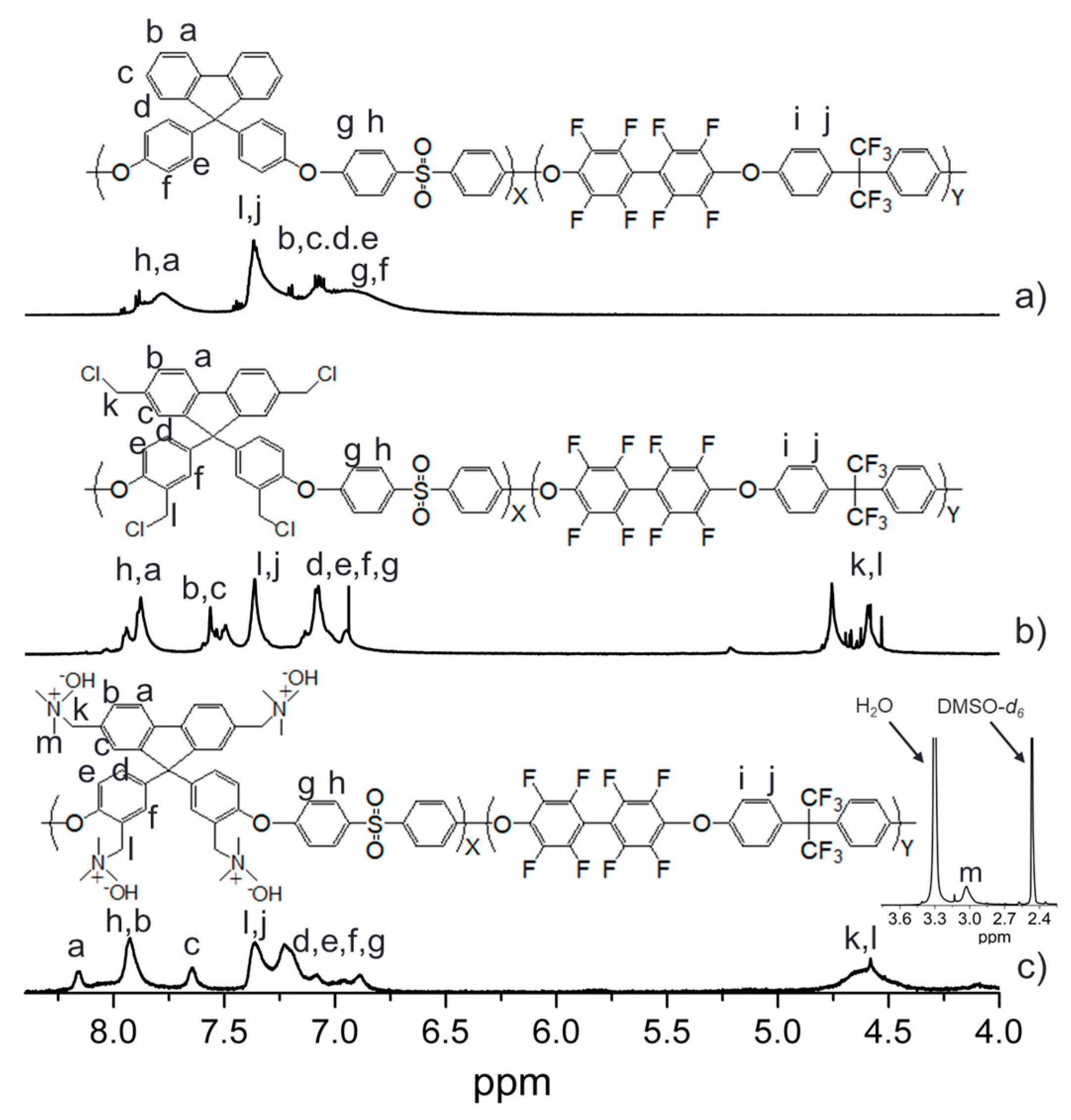
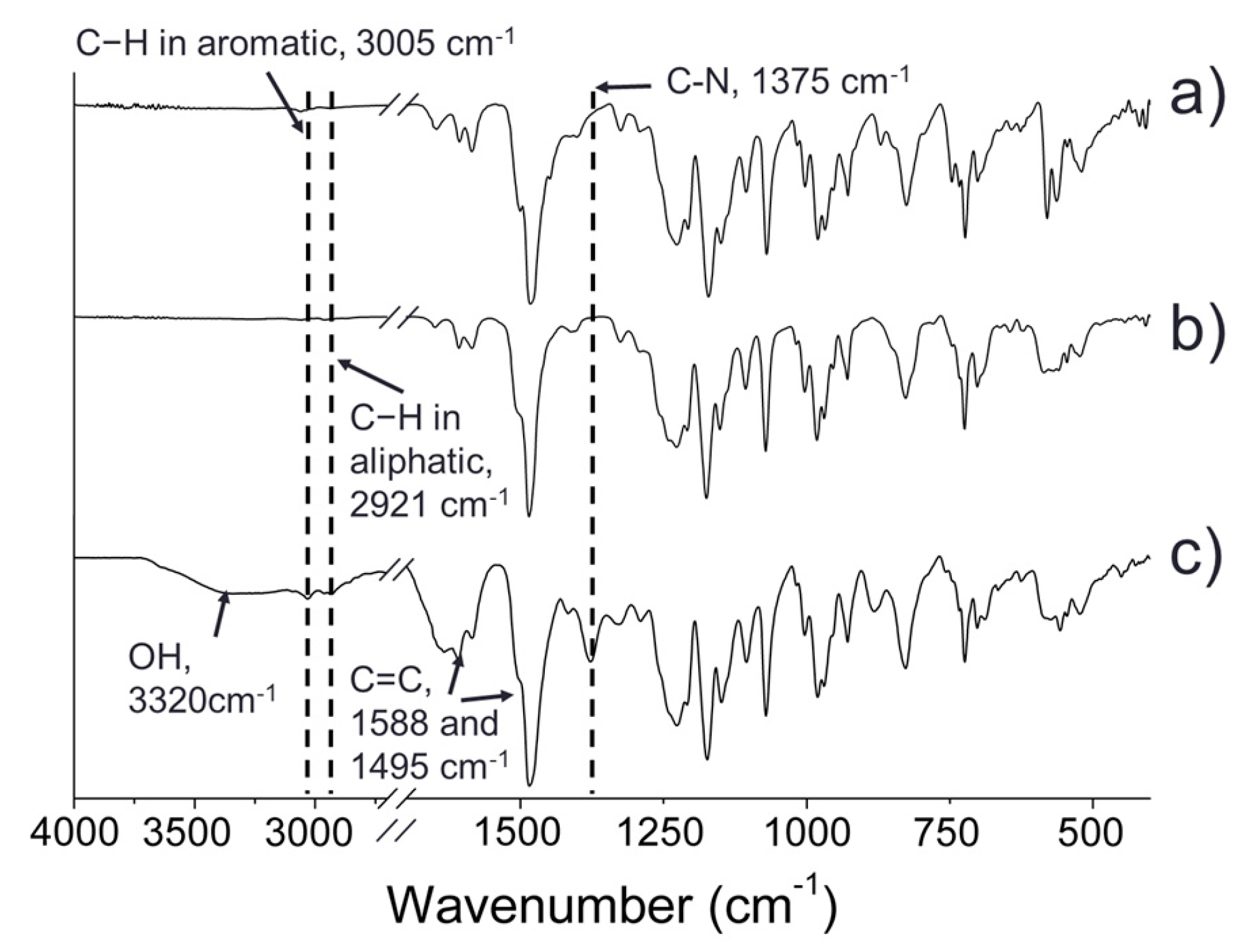
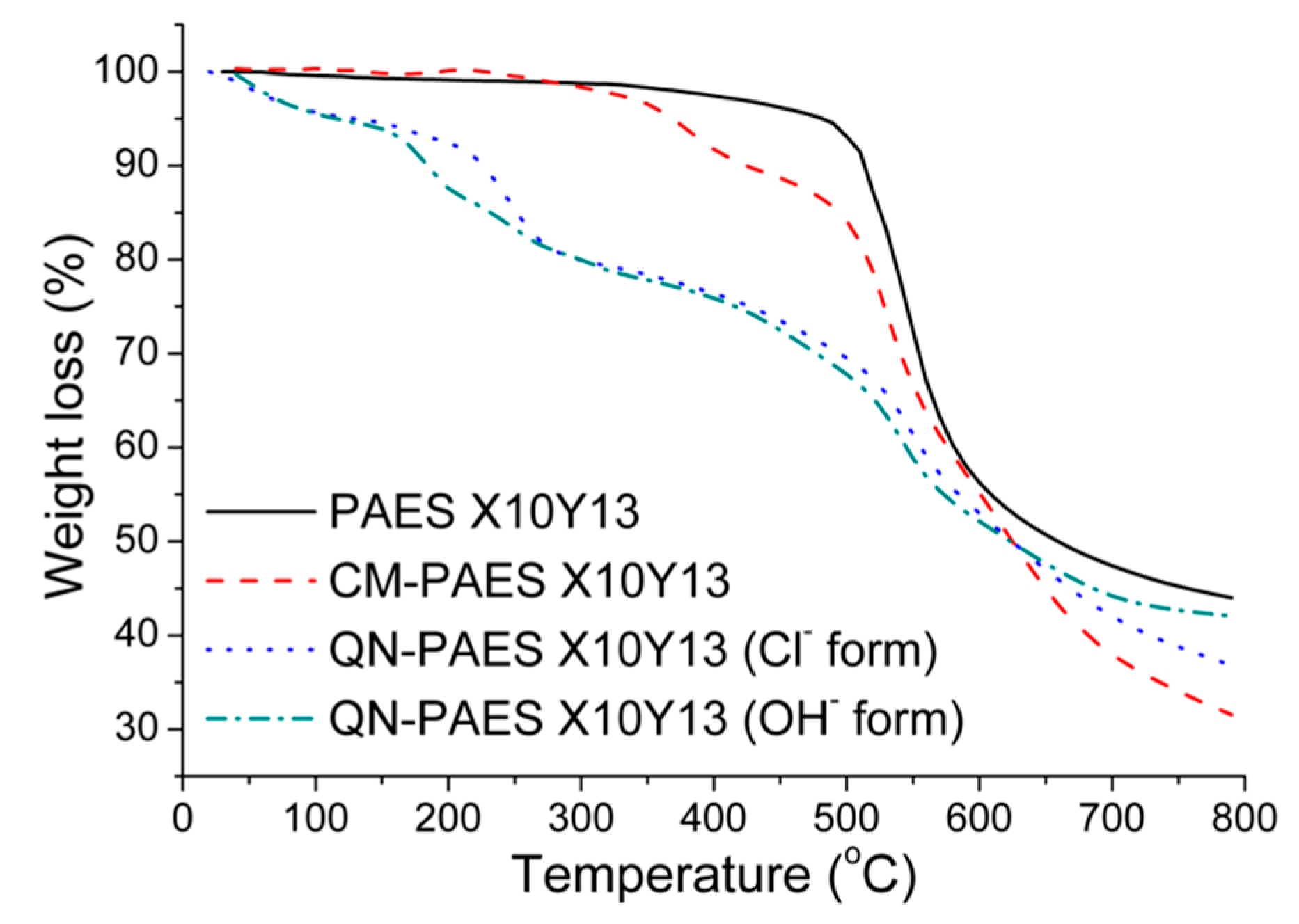
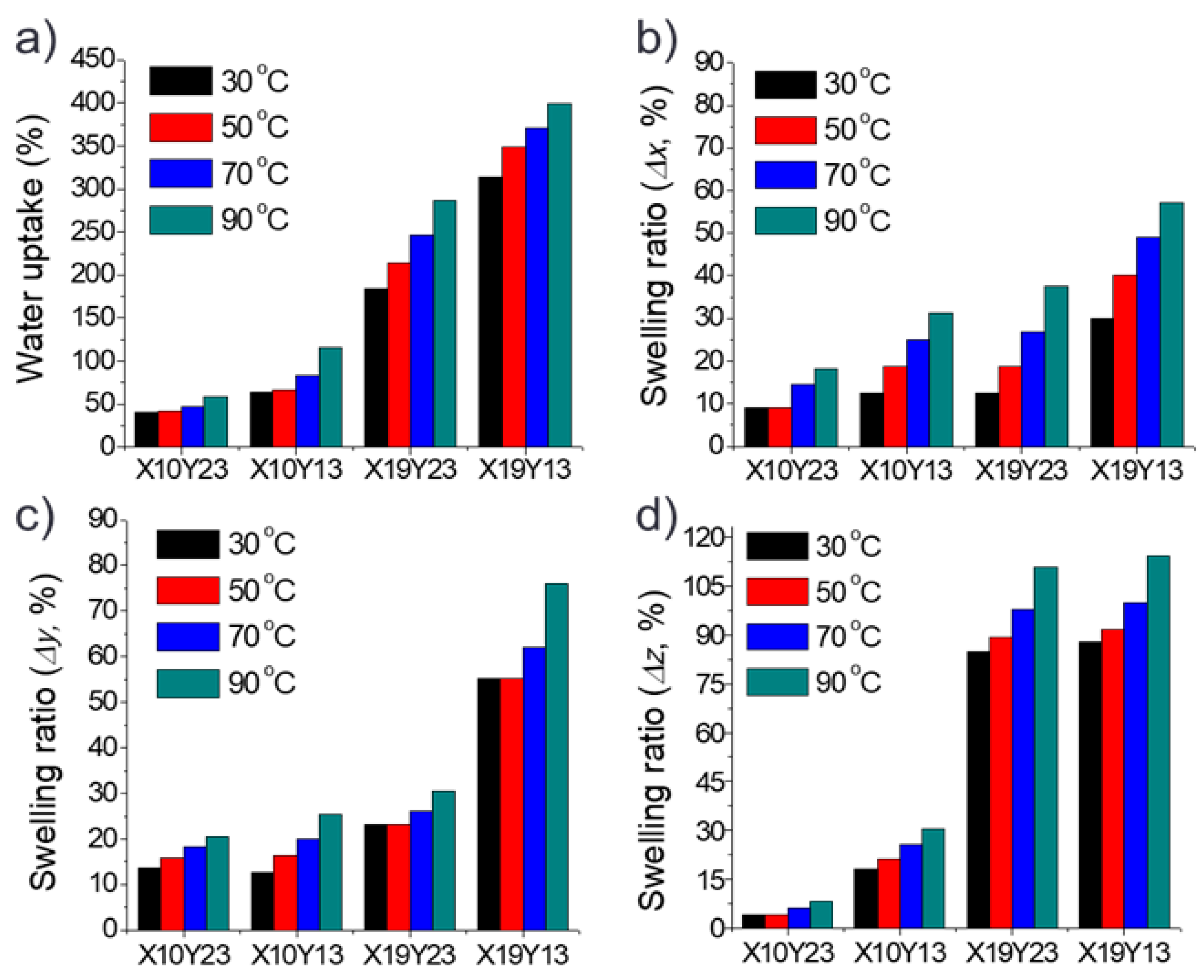

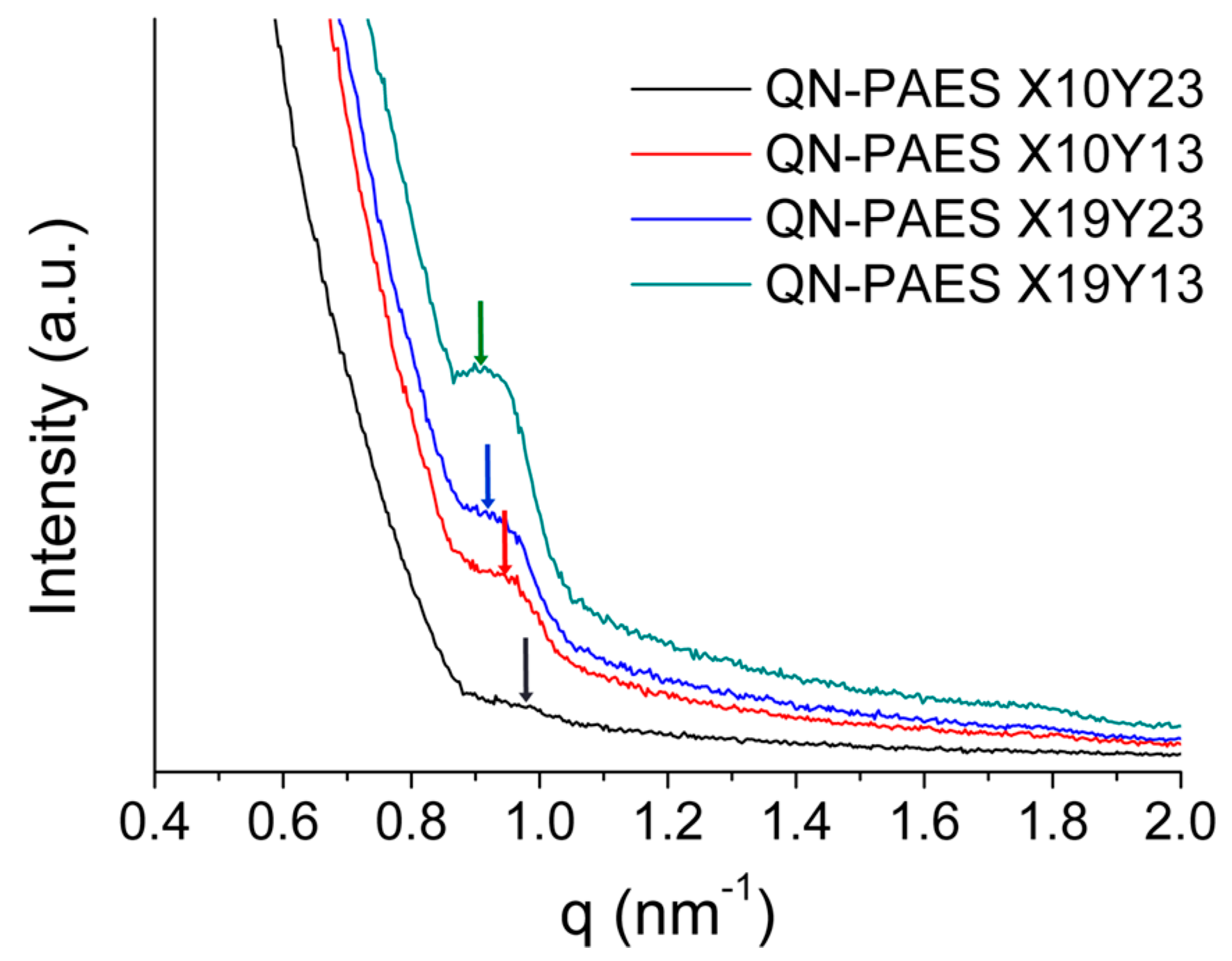
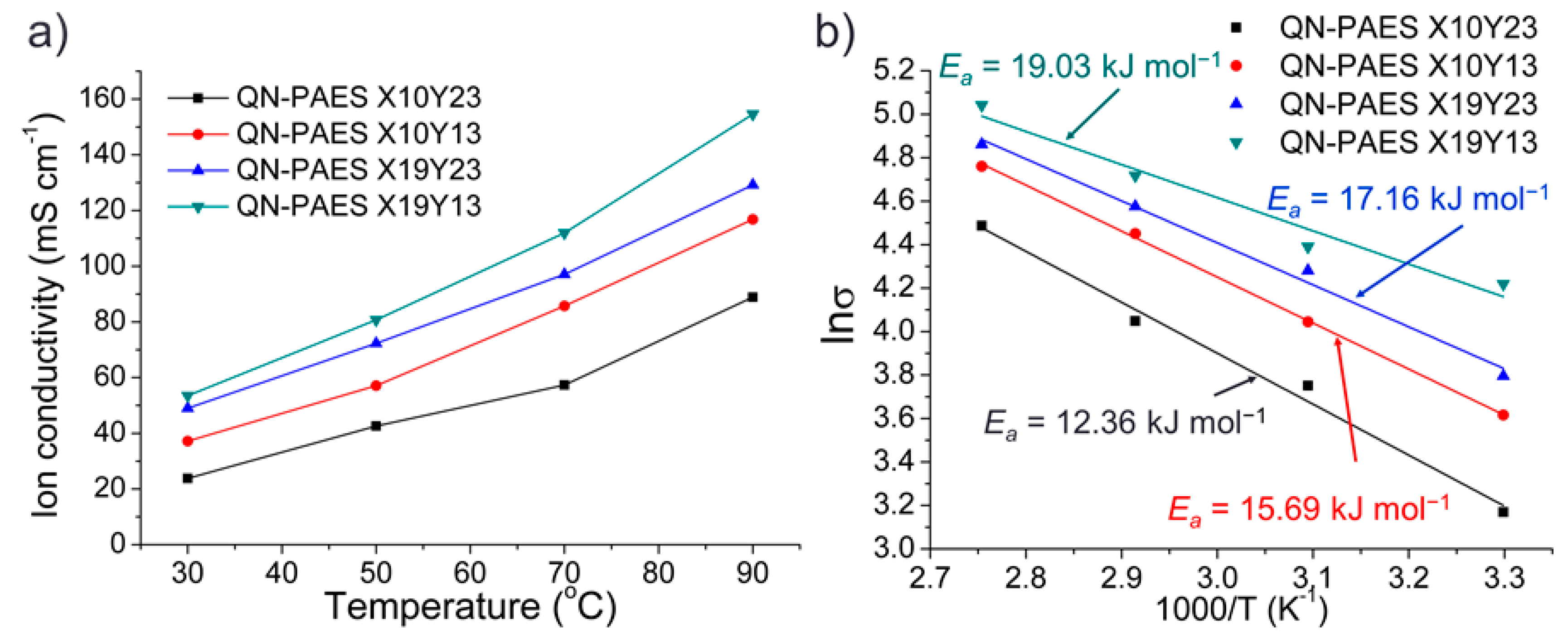


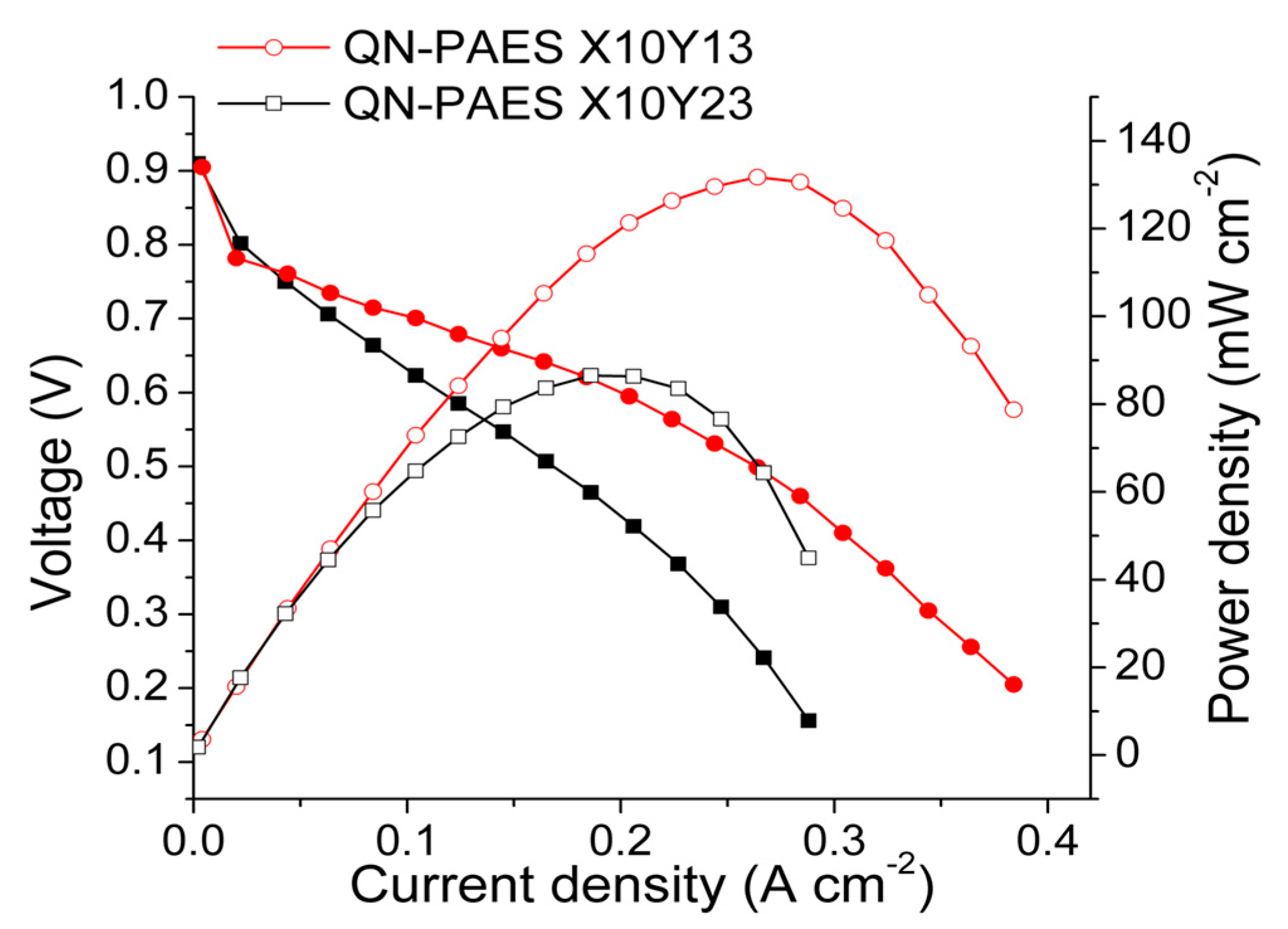
| Polymer | Repeat Unit | Mn (kDa) | Mw (kDa) | PDI (Mw/Mn) | |
|---|---|---|---|---|---|
| (a) | (b) | ||||
| PAS-X10 | 14 | 10 | 5.5 | 9.1 | 1.6 |
| PAS-X19 | 25 | 19 | 10.7 | 17.0 | 1.6 |
| PAE-Y13 | − | 13 | 7.9 | 18.5 | 2.3 |
| PAE-Y23 | − | 23 | 14.5 | 25.7 | 1.7 |
| Polymer | Mn (kDa) | Mw (kDa) | PDI (Mw/Mn) |
|---|---|---|---|
| PAES X10Y23 | 21.2 | 104.5 | 4.9 |
| PAES X10Y13 | 20.3 | 124.2 | 6.1 |
| PAES X19Y23 | 25.2 | 110.9 | 4.3 |
| PAES X19Y13 | 19.8 | 87.5 | 4.4 |
| Membrane | Thickness (µm) | Tensile Strength (MPa) | Young’s Modulus (GPa) | Elongation at Break (%) |
|---|---|---|---|---|
| QN-PAES X10Y23 | 28 | 77.6 | 3.4 | 1.8 |
| QN-PAES X10Y13 | 27 | 67.4 | 2.3 | 2.7 |
| QN-PAES X19Y23 | 25 | 62.3 | 1.0 | 6.9 |
| QN-PAES X19Y13 | 26 | 60.5 | 0.9 | 10.9 |
| QQBPES-2.4OH [33] | − | 17.9 | 0.3 | 44.0 |
| QPE-b [38] | 52 | 48.1 | 0.7 | 54.0 |
| Im-Am-PAEKS-3 [39] | − | 34.5 | 1.4 | 3.6 |
| Membrane | IEC (mequiv g−1) | Hydroxide Conductivity (a) (mS cm−1) | Ea (kJ mol−1) | |||
|---|---|---|---|---|---|---|
| 30 °C | 50 °C | 70 °C | 90 °C | |||
| QN-PAES X10Y23 | 1.36 | 23.8 | 42.6 | 57.3 | 88.9 | 19.03 |
| QN-PAES X10Y13 | 1.59 | 37.2 | 57.1 | 85.7 | 116.8 | 17.16 |
| QN-PAES X19Y23 | 1.82 | 49.0 | 72.3 | 97.1 | 129.2 | 15.69 |
| QN-PAES X19Y13 | 2.10 | 53.5 | 80.7 | 111.9 | 154.8 | 12.36 |
| Membrane | Scattering Vector (qmax, nm–1) | d-Spacing (nm) |
|---|---|---|
| QN-PAES X10Y23 | 0.98 | 6.41 |
| QN-PAES X10Y13 | 0.96 | 6.54 |
| QN-PAES X19Y23 | 0.94 | 6.68 |
| QN-PAES X19Y13 | 0.91 | 6.90 |
| Membrane | IEC (mequiv g−1) | σ (mS cm−1) | Ref. |
|---|---|---|---|
| QN-PAES X10Y23 | 1.36 | 88.9 (90 °C) | this work |
| QN-PAES X10Y13 | 1.59 | 116.8 (90 °C) | this work |
| QN-PAES X19Y23 | 1.82 | 129.2 (90 °C) | this work |
| QN-PAES X19Y13 | 2.10 | 154.8 (90 °C) | this work |
| MM-PES-1.5-1 | 2.27 | 78.3 (80 °C) | [18] |
| QPE-A22B24 | 2.29 | 91.0 (90 °C) | [50] |
| SEBS-CH2-QA-1.5 | 1.23 | 56.4 (80 °C) | [51] |
| IPAES-TMA | 2.39 | 67.2 (80 °C) | [52] |
| PAEK-QTPM-30 | 1.58 | 47.0 (80 °C) | [53] |
| PAES-Q-90 | 1.54 | 93.5 (80 °C) | [54] |
| C-QAPPESK/OH-5 | 1.42 | 17.5 (70 °C) | [55] |
© 2018 by the authors. Licensee MDPI, Basel, Switzerland. This article is an open access article distributed under the terms and conditions of the Creative Commons Attribution (CC BY) license (http://creativecommons.org/licenses/by/4.0/).
Share and Cite
Chu, J.Y.; Lee, K.H.; Kim, A.R.; Yoo, D.J. Improved Physicochemical Stability and High Ion Transportation of Poly(Arylene Ether Sulfone) Blocks Containing a Fluorinated Hydrophobic Part for Anion Exchange Membrane Applications. Polymers 2018, 10, 1400. https://doi.org/10.3390/polym10121400
Chu JY, Lee KH, Kim AR, Yoo DJ. Improved Physicochemical Stability and High Ion Transportation of Poly(Arylene Ether Sulfone) Blocks Containing a Fluorinated Hydrophobic Part for Anion Exchange Membrane Applications. Polymers. 2018; 10(12):1400. https://doi.org/10.3390/polym10121400
Chicago/Turabian StyleChu, Ji Young, Kyu Ha Lee, Ae Rhan Kim, and Dong Jin Yoo. 2018. "Improved Physicochemical Stability and High Ion Transportation of Poly(Arylene Ether Sulfone) Blocks Containing a Fluorinated Hydrophobic Part for Anion Exchange Membrane Applications" Polymers 10, no. 12: 1400. https://doi.org/10.3390/polym10121400





